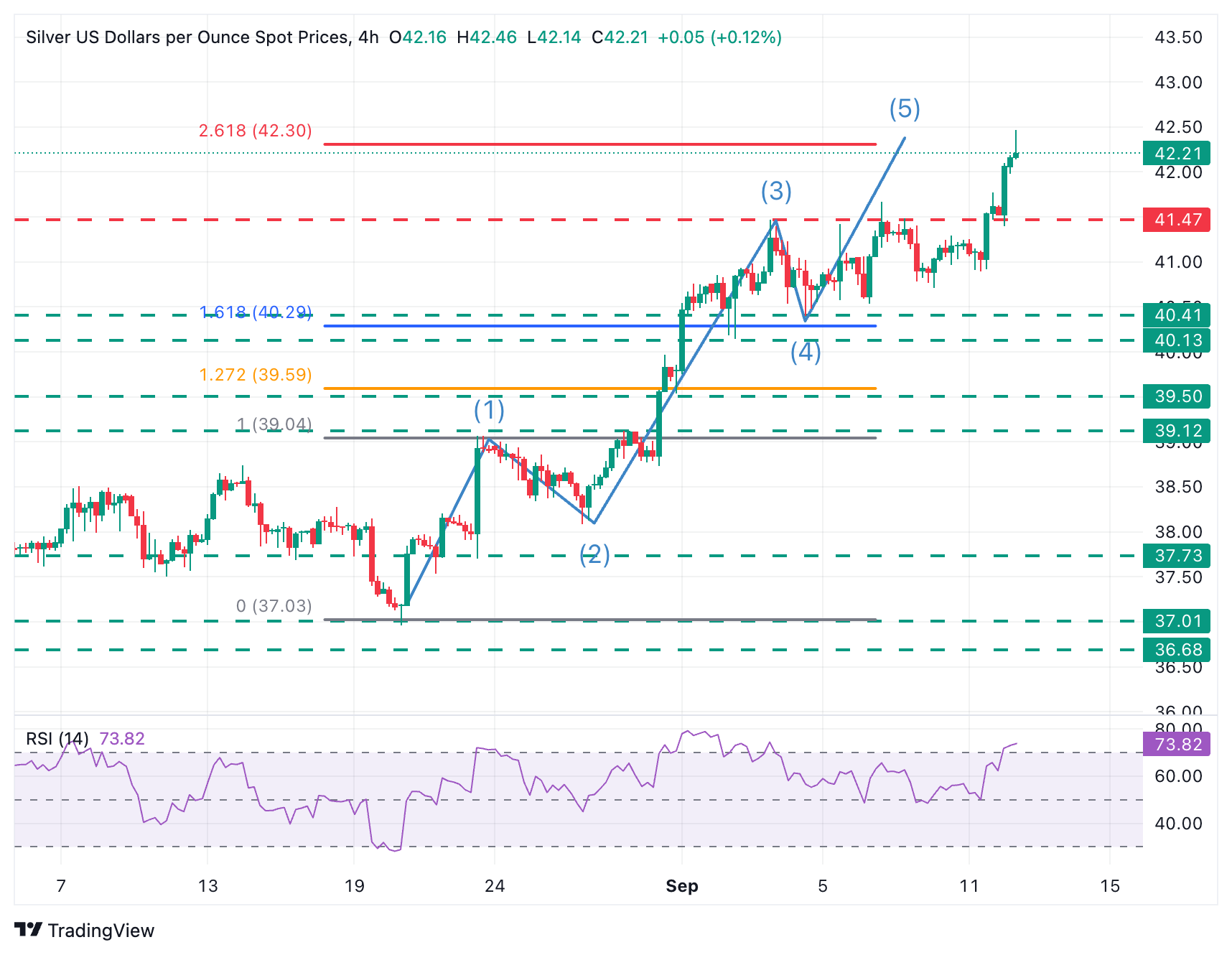Silver Price Forecast: XAG/USD hits fresh long-term highs at $42.45
- Silver rall¡ies further on US Dollar weakness and hits fresh long-term highs at $42.45.
- Weak US employment data and moderate inflation pave the path for a Fed cut next week.
- XAG/USD might have reached the target of the bullish cycle from mid-August, at $42.45.
Silver’s (XAG/USD) broke higher on Thursday and has reached a fresh 14-year high at $42.45, favoured by US Dollar weakness after US Jobless Claims and CPI data paved the path for a Fed rate cut next week.
US Initial Jobless Claims rose at their fastest pace in the last four years last week, which, together with the downward revision of the Nonfarm Payrolls data reported earlier this week, highlights the deterioration of the US labour market.
At the same time, August Consumer Prices index broadly met market expectations, with a 2.9% year-on-year reading from the 2.7% increase seen in July, while core inflation remained steady, at a 3.1% yearly pace. These figures have curbed hopes of a 50 bps rate cut but keep expectations of a quarter-point easing move alive.
Technical Analysis: Bulls might struggle to extend gains beyond $42.50

Looking from an Elliott Wave perspective, the pair might have reached the target of a 5-wave bullish cycle at the $42.50 area. This level is the 261.8% Fibonacci extension of wave 1 (August 20-25 rally).
Beyond that, the 4-hour RSI shows a bearish divergence, suggesting that bulls are losing steam after having rallied beyond 14% since mid–August. Beyond here, the next target would be the $43.00 level.
To the downside, immediate support is the $41.50 previous resistance area. Further down, the area between September 2 and 4 lows at 40.40 and 40.15 is likely to be the next bearish target.
Silver FAQs
Silver is a precious metal highly traded among investors. It has been historically used as a store of value and a medium of exchange. Although less popular than Gold, traders may turn to Silver to diversify their investment portfolio, for its intrinsic value or as a potential hedge during high-inflation periods. Investors can buy physical Silver, in coins or in bars, or trade it through vehicles such as Exchange Traded Funds, which track its price on international markets.
Silver prices can move due to a wide range of factors. Geopolitical instability or fears of a deep recession can make Silver price escalate due to its safe-haven status, although to a lesser extent than Gold's. As a yieldless asset, Silver tends to rise with lower interest rates. Its moves also depend on how the US Dollar (USD) behaves as the asset is priced in dollars (XAG/USD). A strong Dollar tends to keep the price of Silver at bay, whereas a weaker Dollar is likely to propel prices up. Other factors such as investment demand, mining supply – Silver is much more abundant than Gold – and recycling rates can also affect prices.
Silver is widely used in industry, particularly in sectors such as electronics or solar energy, as it has one of the highest electric conductivity of all metals – more than Copper and Gold. A surge in demand can increase prices, while a decline tends to lower them. Dynamics in the US, Chinese and Indian economies can also contribute to price swings: for the US and particularly China, their big industrial sectors use Silver in various processes; in India, consumers’ demand for the precious metal for jewellery also plays a key role in setting prices.
Silver prices tend to follow Gold's moves. When Gold prices rise, Silver typically follows suit, as their status as safe-haven assets is similar. The Gold/Silver ratio, which shows the number of ounces of Silver needed to equal the value of one ounce of Gold, may help to determine the relative valuation between both metals. Some investors may consider a high ratio as an indicator that Silver is undervalued, or Gold is overvalued. On the contrary, a low ratio might suggest that Gold is undervalued relative to Silver.